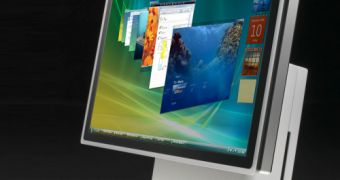If you think that Windows Vista was a fast operating system, then just wait for the first service pack. According to data released by Microsoft, Vista SP1 with weigh in at a maximum of 1.5 GB. As Windows Vista comes on both 32-bit and 64-bit flavors, the first service pack for the operating system will inherently follow the same pattern. In this context, the 64-bit version of Vista SP1 will be the heavyweight of the refresh with no less than 1.5 GB. However, the 32-bit variant of the service pack for Vista is not far behind with no less than 1 GB. These figures however are associated with the standalone installers for Vista SP1. The version of Vista Service Pack 1 that will be delivered for download through Windows Update and Windows Software Update Services (WSUS) will be approximately 50 MB.
"It's true that at first glance it will look like a lot is changing, and it's true that there are thousands of files being changed to varying degrees in Windows Vista SP1. However, the first measure of "size" most people will encounter will likely be the download of Windows Vista SP1 through Windows Update or Windows Server Update Services (WSUS), which we predict will be about 50 MB. The second measure of size will be the free disk space requirement for installing Windows Vista SP1, which is currently around 7 GB for the beta, although we will be working to bring this down for the final version as we optimize the servicing algorithms used," revealed Jon DeVaan, Senior Vice President of the Windows Core Operating System division at Microsoft.
Yes, that's right. The standalone installer for 32-bit Vista SP1 will require no less than 7 GB of free hard disk space. And of course that with the 64-bit version the requirements nearly double with no less than 12 GB of free space. Microsoft currently plans no less than three deployment scenarios for Vista SP1. Express, Standalone, and Slipstream. The Express version will be the 50 MB download delivered over Windows Update and WSUS for a specific machine. The Standalone package is designed to be implemented on computers with limited Internet connectivity.
"The download size is larger than the express package, but customers can apply a single package to any Windows Vista version and language combination (within a platform). Distribution tools like System Center Configuration Manager 2007 use stand-alone packages to deploy Windows Vista SP1," explained Microsoft's Brandon LeBlanc.
And of course, the Slipstream Vista SP1 delivery model is essentially a media with the refresh addressed at corporate environments. Via the Slipstream version, users will be able either to upgrade the existing Vista operating systems or deploy the service pack on top of existing installations. "Availability will be limited. Microsoft will update Windows Vista retail media with Windows Vista SP1 slipstream media in the future. Slipstream media will also be available to Volume Licensing customers," LeBlanc added.
Windows Vista SP1 is currently planned for general availability in the first quarter of 2008, most probably following the late February launch of Windows Server 2008, formerly codenamed Longhorn.

 14 DAY TRIAL //
14 DAY TRIAL //